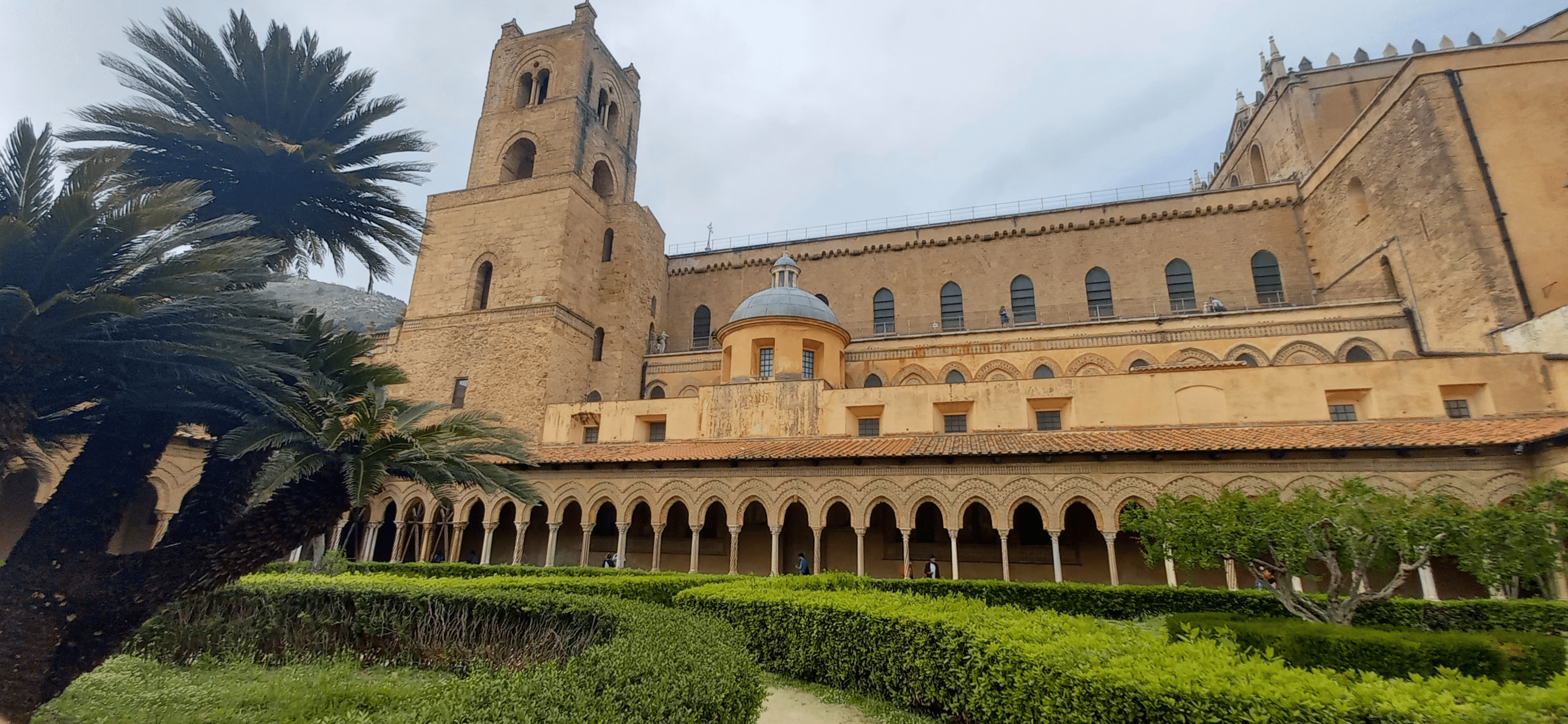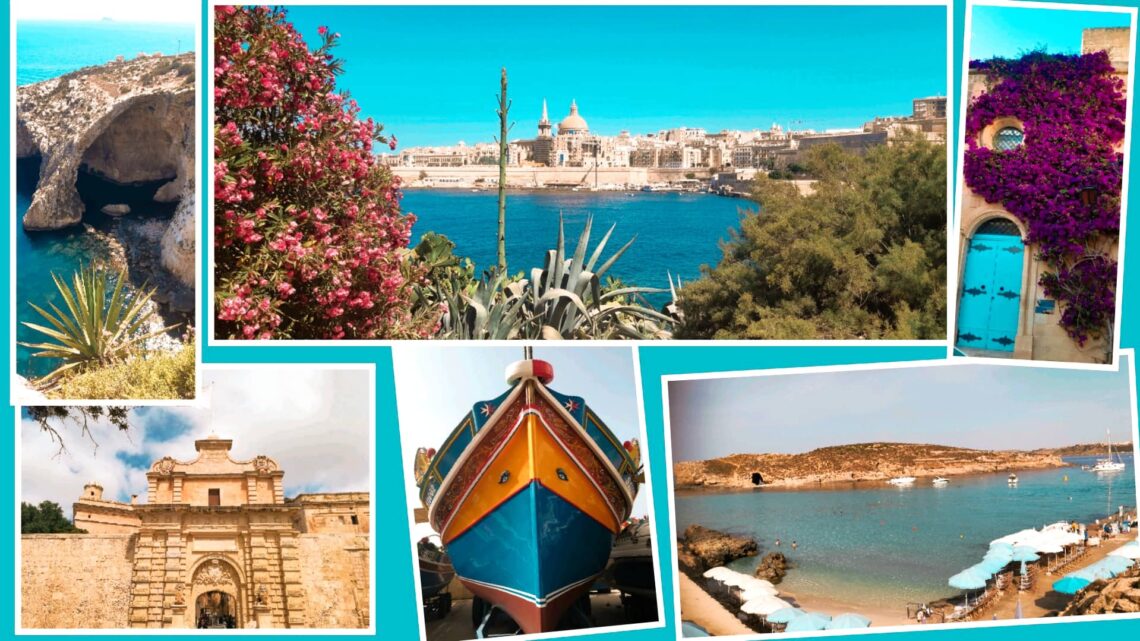
What to Do in Malta in One Week? My Must-Sees
Do you want to visit Malta?
Malta is a small island state located south of Sicily. It has a lot of treasures to be discovered.
Old stones, turquoise waters, Mediterranean culture, cosmopolitan atmosphere… there is something for everyone.
Malta is part of the European Union, so it is very easy to get there if you are in Europe.
The archipelago has a rich cultural heritage, shaped by the various powers that ruled over Malta in the past (notably the Phoenicians, the Arabs, the Normans, the Order of St John of Jerusalem, the French, the British).
Moreover, with over 300 days of sunshine a year, Malta can be visited almost all year round (avoid July and August – it’s too hot!).
A stay in this Mediterranean country will let you marvel and experience new adventures. Whether you are a history buff, a nature lover, a sporty person or simply want a change of scenery, you will find what you are looking for in Malta.
As I have been living in Malta since 2017, I will share with you my experience to help you plan your trip to Malta.
Note: This blog post is a collection of the must-sees and must-do’s in Malta according to me. The list of places and activities is varied enough to suit most people. Adapt your programme according to your interests: visit more museums if you are passionate about history, plan more time at the beach if you want to relax and unwind, go to Paceville if you like the nightlife…
So, what to do in Malta in a week? Follow the guide!
Table of Contents
ToggleDay 1 – Valletta, the capital of Malta
Valletta – the capital of Malta – is really a must-see. It is my favourite place in Malta. I often go there to walk around, without getting tired of it.
With an area of 0.8km², Valletta can easily be visited on foot.
Imagine a peninsula, bathed by the Mediterranean Sea and sprinkled with historical monuments and traditional limestone buildings.
At the entrance to the capital stands the Triton Fountain.
You enter Valletta via the bridge over the capital’s ditch.
Visit Upper Barrakka Gardens, a garden with a panoramic view over the Grand Harbour and the Three Cities. Go there at 12 pm or 4 pm and you’ll be rewarded with a particular show, a legacy of English colonisation: the firing of a cannon over the Grand Harbour.
Lower Barrakka Gardens, Valletta’s second garden, is also worth a visit. It is quieter and offers a panoramic view.
Additionally, I recommend you to visit St John’s Co-Cathedral. Its sober façade hides a splendid and richly decorated Baroque interior, as well as paintings by Caravaggio.
Stroll through the typical little streets and enjoy a Maltese pastry (honey ring, imqaret…) or ice cream.
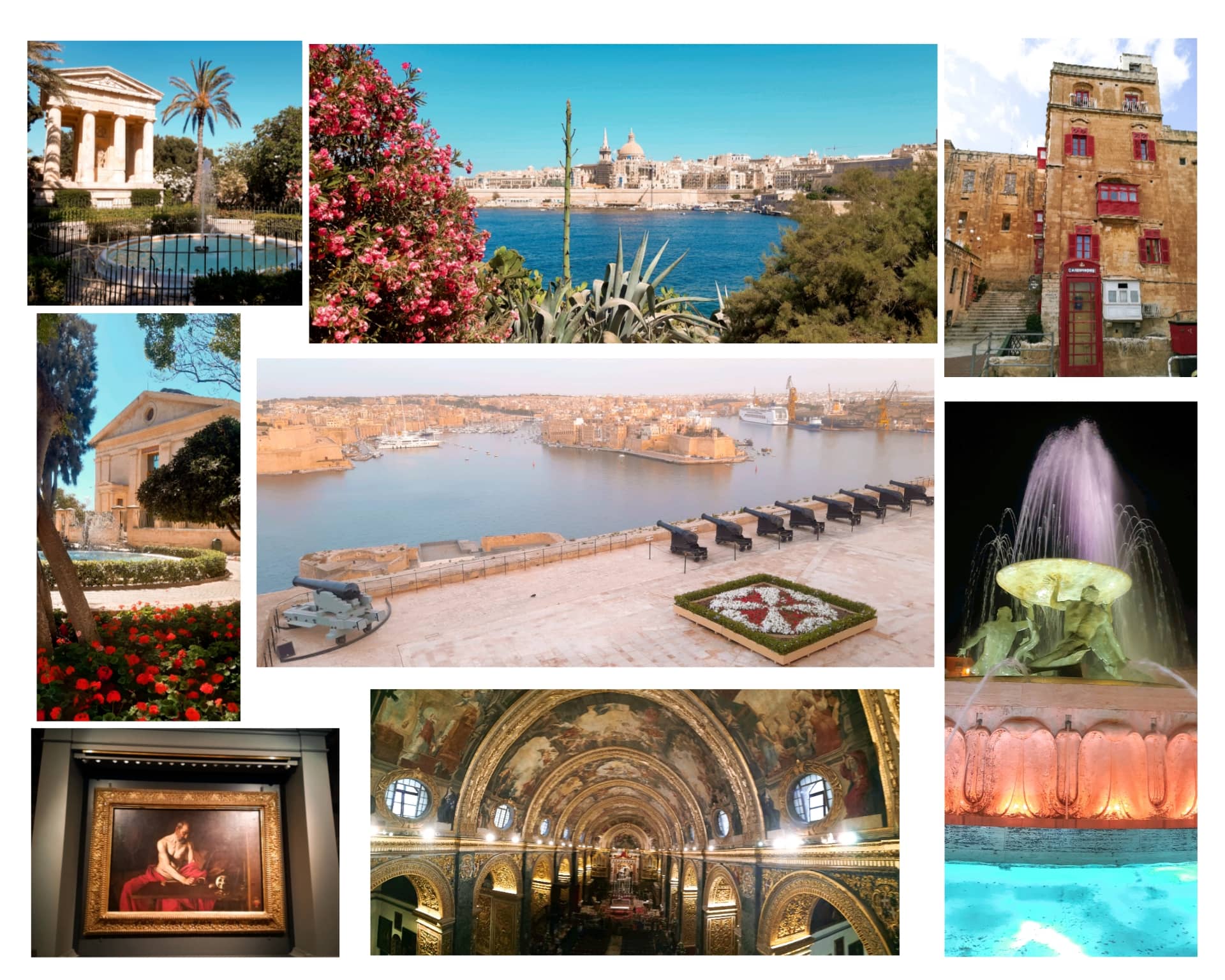
Middle: Upper Barrakka Gardens, Triton Fountain on the right.
Bottom: St John’s Co-Cathedral.
Day 2 – The Three Cities from Valletta
The Three Cities is another place to be visited during a stay in Malta.
I recommend you to go there from Valletta, although you could just go directly to the Three Cities. Below the Upper Barrakka Gardens and its impressive lift, there is a dock, from which you can cross the Grand Harbour by a traditional boat: the water taxi (or dgħajsa).
At the end of this trip, you arrive at Birgu (or Vittoriosa), the first of the three fortified cities. The other two are Isla (Senglea) and Bormla (Cospicua).
Stroll through the typical little streets, discover the traditional Maltese houses, the many churches, the small harbours and the breathtaking view of Valletta. The Three Cities have the advantage to offer a quieter environment than the capital.
If you want to try the local street food, head to a pastizzeria for pastizzi, a type of puff pastry filled with ricotta or pea puree (and sometimes meat).
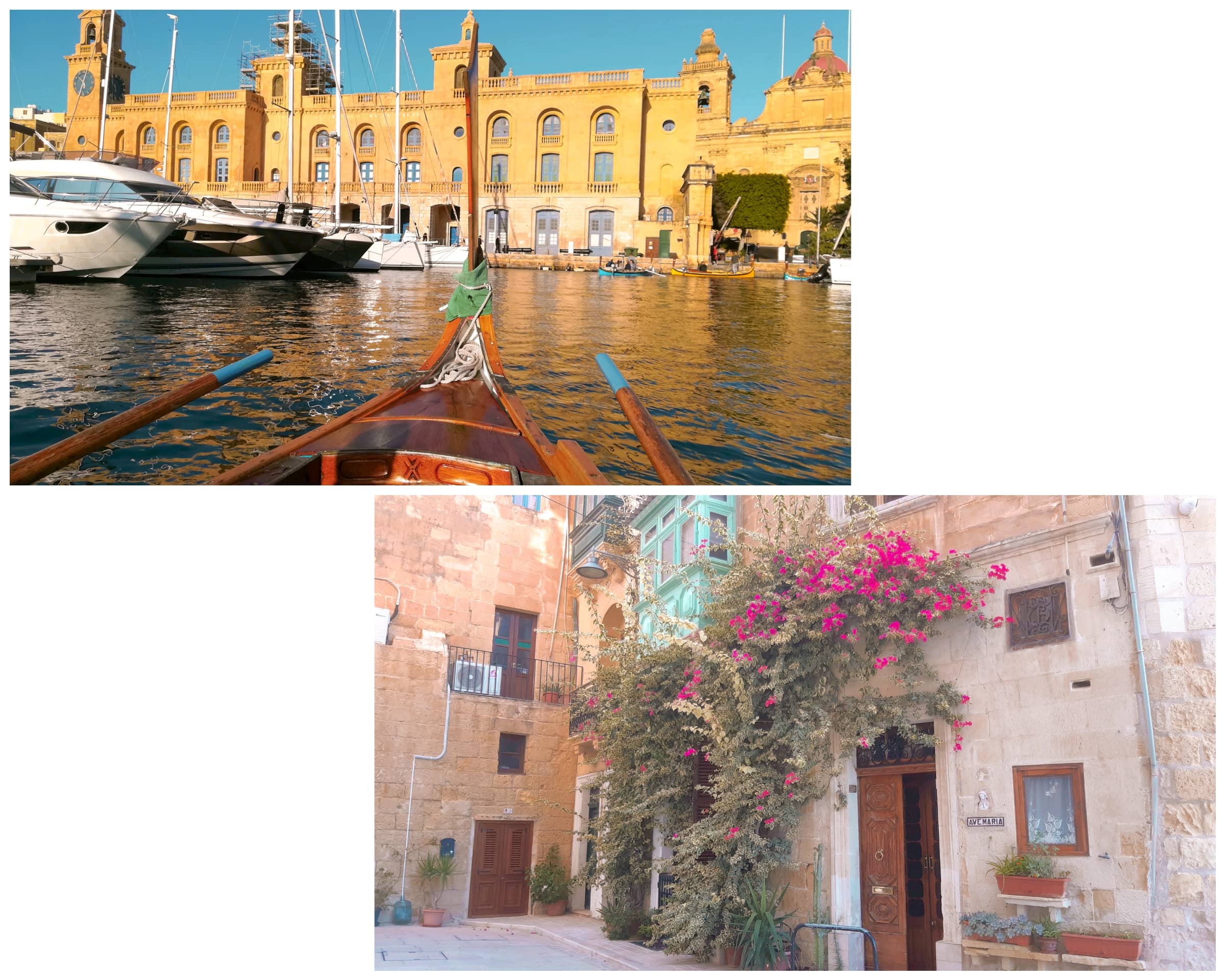
Day 3 – Blue Grotto – Dingli Cliffs – Mdina – Rabat: visit the south of Malta
For your 3rd day, head for the south of Malta! The south of the island is less affected by urbanization than the north and offers a more rural scenery.
If you decide to explore Malta by bus, you can take the 201 bus from the airport. It runs from the airport to Mdina, passing through Blue Grotto and Dingli Cliffs.
I recommend you to go to Blue Grotto first. The sun exposure and colours are at their best in the morning. Stop at the viewpoint overlooking the main cave before heading down. A boat tour allows you to visit this group of caves and admire the turquoise hues of the water. During the summer season (May to October I’d say, beyond that if you don’t mind swimming in the cool water) you can then swim and even snorkel.
Then continue your way along the south coast. You will find Ħaġar Qim, the megalithic temples overlooking the Mediterranean Sea. Visit them if you are a history buff and have enough time.
Further along the coast are the Dingli Cliffs, impressive cliffs that are about 250 meters high. If you can, take a walk there at the end of the day to watch the sunset.
Finally, don’t miss Mdina. Go through the gate, famous for being featured in the Game of Thrones series, and enter this small fortified town, known as the Silent City. With its medieval streets, cathedral and old houses, Mdina takes you on a journey through time. At its end, it offers a panoramic view over the north of Malta.
If you have time, leave Mdina and finish your trip with a short walk in Rabat, which is just next door.
Note: If you are interested in handicrafts, you can visit Ta’ Qali Crafts Village (not far from Midna), a village dedicated to Maltese crafts. There, you will find the glassblowers, among others.
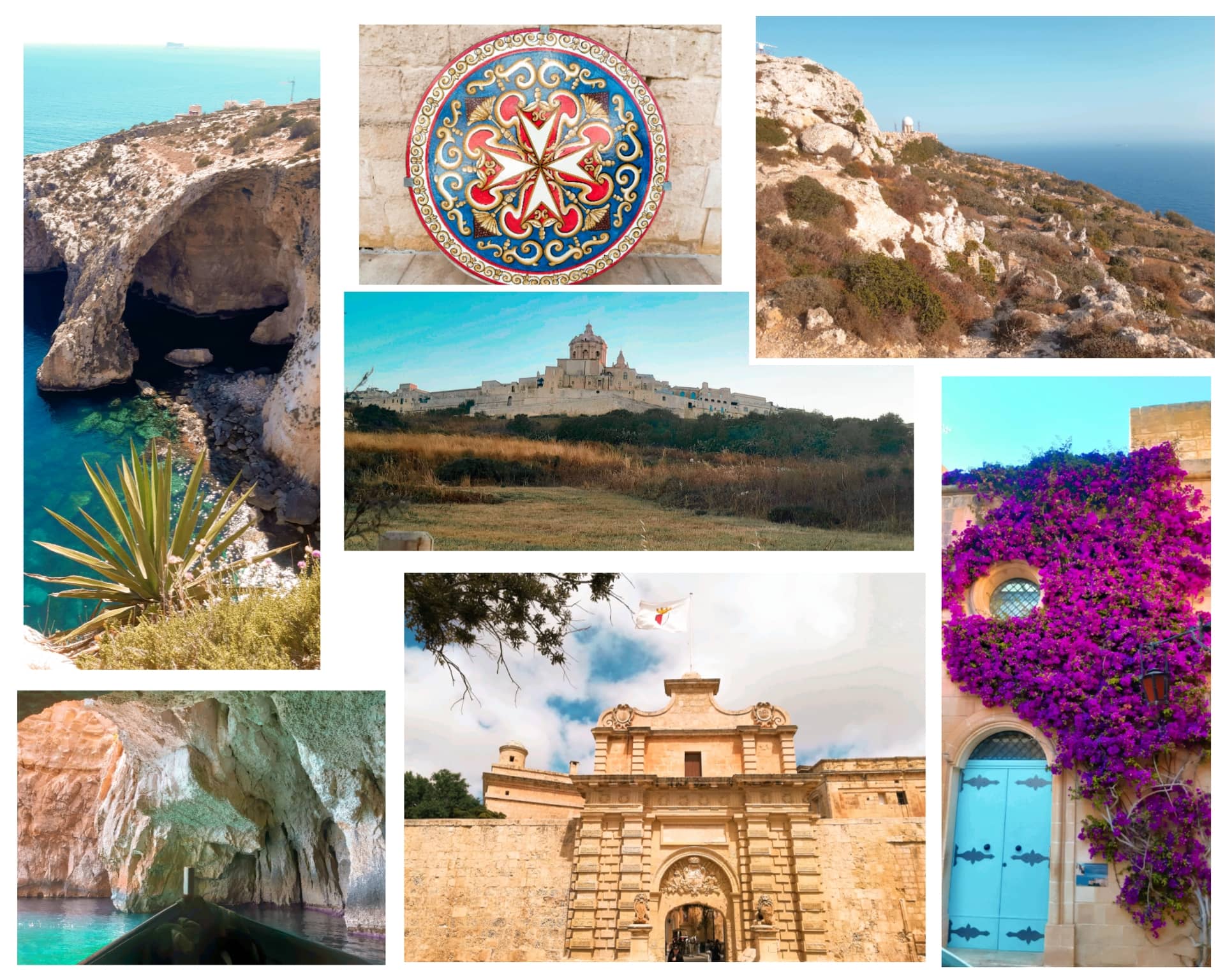
Middle and bottom right: Mdina
Top right: Dingli Cliffs
Day 4 – Gozo, Malta’s natural and authentic little sister
Plan a full day to discover Malta’s little sister: Gozo. It is smaller and more preserved from the increasing urbanization than Malta. As I live in Malta, I like to spend a day in Gozo when I need nature and a quieter environment.
To get to Gozo, take the ferry from Cirkewwa in the far north of the island and enjoy the ride on the upper deck. There is also a new ‘fast ferry’ from Valletta (for passengers only).
If you want to see as many places as possible in one day, I recommend taking a Hop On – Hop Off sightseeing bus, which allows you to visit up to 15 different places.
What are the must-see places in Gozo?
- Victoria (or Rabat)
Victoria, the (small) capital of Gozo, is in my opinion one of the must-sees when visiting Gozo. I recommend stopping there around lunchtime to have lunch. Wander through the streets of the old town, discover the Basilica of St George and its typical little square, and then go upstairs to explore the citadel. The citadel overlooks the capital and offers a spectacular view over the whole island of Gozo.
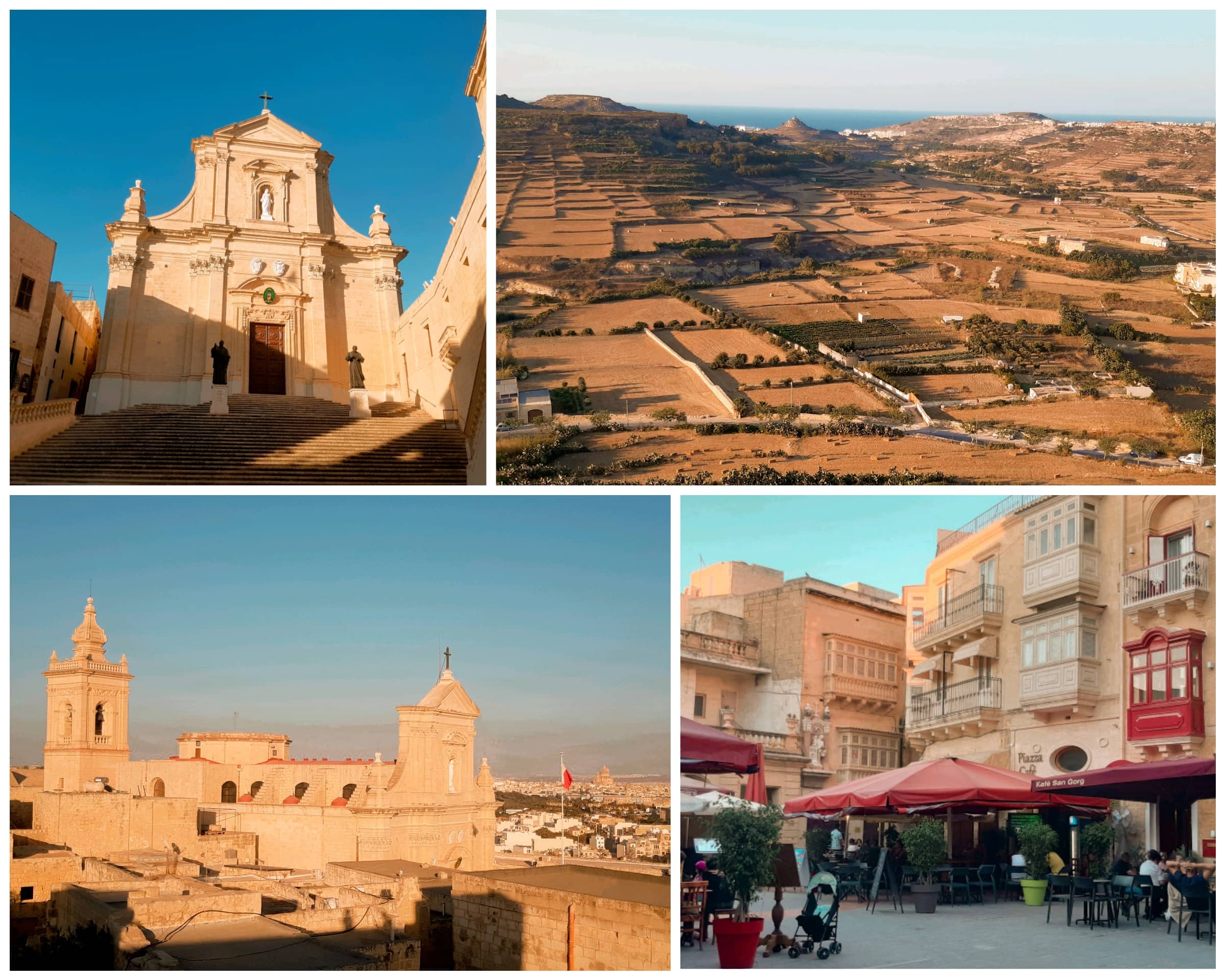
Left: the Citadel.
Top right: panoramic view from the Citadel.
Bottom right: Saint George’s Square
- Azure Window (or Dwejra Window)
Azure Window is probably the most iconic place in Gozo. It is a large stone arch rising out of the sea, which unfortunately collapsed in 2017 due to erosion. The place is still spectacular though, especially at sunset.
Turn your back on the ancient Azure Window and you will discover another treasure: Inland Sea. This is an inner bay, surrounded by a large rock wall but connected to the sea by a tunnel dug in the wall. It is possible to take a boat ride through the tunnel to discover what lies on the other side.
- Ta’ Pinu
The Basilica of Our Lady of Ta’ Pinu is worth a visit. From the Gozitan countryside, you can see its neo-Romanesque silhouette standing out in the sky. What makes it special? The numerous mosaics depicting scenes from the Bible that adorn its square.
- Xlendi
Xlendi is a typical Gozitan bay. Here too you can take a boat trip and explore the cliffs and caves from the sea.
- Ramla Bay
Ramla Bay is a small red sandy beach that offers a nice contrast with the turquoise water. Quiet in the winter season, it is crowded with tourists and locals in the summer months.

Top right: boat trip from Xlendi.
Bottom left: typical alley in Xlendi.
Middle: Basilica of Our Lady of Ta’ Pinu.
Bottom right: Inland Sea.
Day 5 – Sliema – Marsaxlokk – Saint Peter’s Pool
In the morning, I suggest that you explore the area around your hotel, hostel or other accommodation. Here I take Sliema as an example because many tourists stay there: in Sliema, you can find plenty of hotels and buses to explore the whole island. If you stay in a guesthouse in the south of the island, go to explore the Maltese countryside!
Wherever you are, be sure to visit the churches. Did you know that there are 365 churches in Malta? You could visit one a day, for a year!
If you are staying in Sliema, I suggest you walk along the promenade along the sea to St Julian’s. There you will find a large cat statue (a testament to Malta’s cat craze), Balluta Bay and Spinola Bay.
In the afternoon, head to the south of the island to discover Marsaxlokk, the traditional fishing village. Every Sunday morning there is a fish and craft market (watch out for the crowds). This small village is very colourful. You will discover the emblematic fishing boat of Malta: the luzzu. It is very colourful and adorned with a pair of eyes. This is a Phoenician survival, supposed to protect the luzzu from the vagaries of the sea and to favour fishing.
From Marsaxlokk, you can walk to Saint Peter’s Pool. This natural pool offers a beautiful setting to swim or relax, but is very busy in summer.
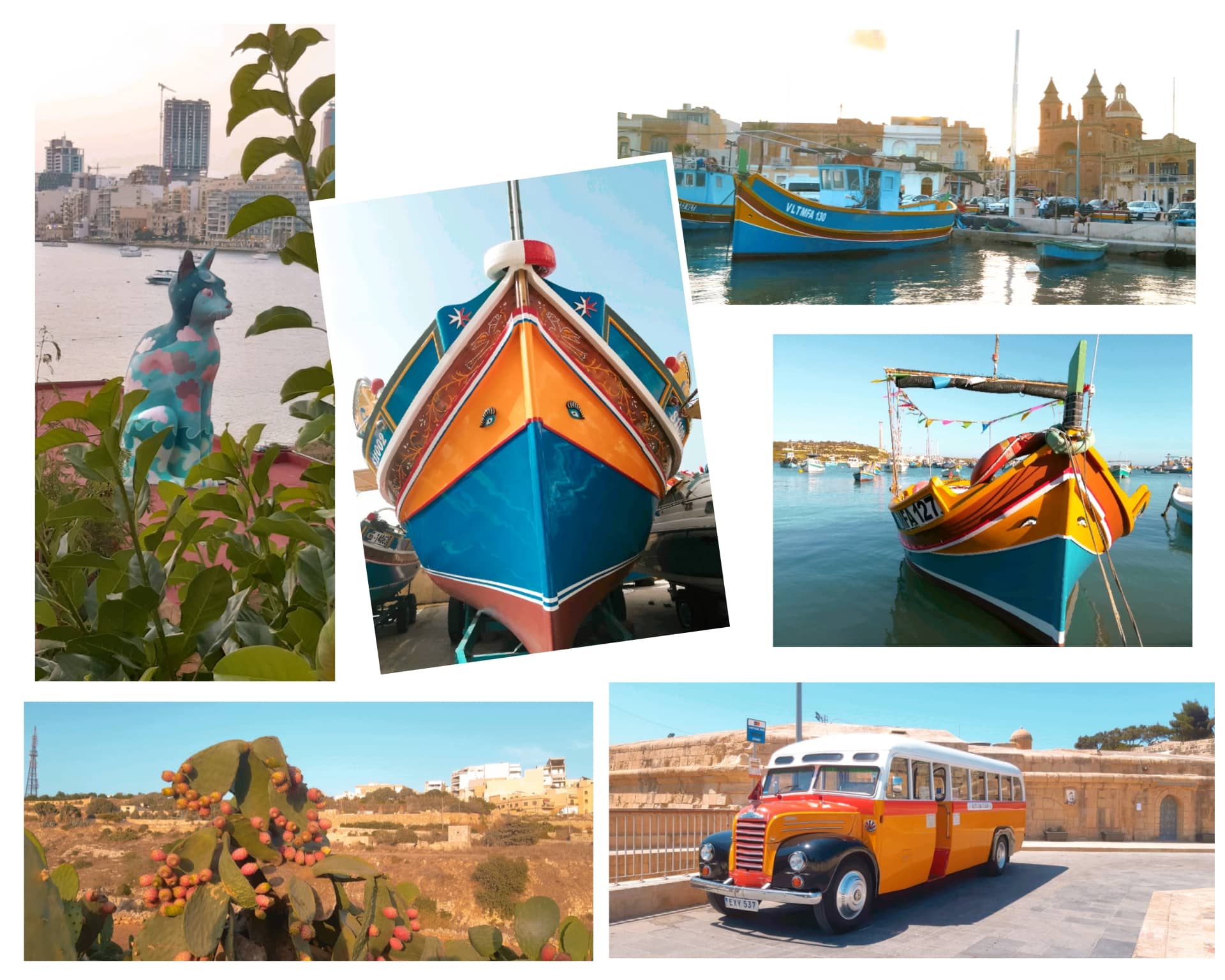
Top right: Marsaxlokk and its luzzijiet, the traditional fishing boats.
Bottom left: Prickly pear trees in the Maltese countryside.
Bottom right: Vintage bus to Sliema from Valletta.
Day 6 – Comino: a paradise island
Comino is the third island in the Maltese archipelago to be visited, situated between Malta and Gozo. You can get there from Cirkewwa or even from Sliema (by taking a one-day cruise).
Comino is famous for its Blue Lagoon and its turquoise waters. This heavenly spot is unfortunately crowded in summer. You can go for a walk around the island. On your way, you will find small, quiet coves for swimming.
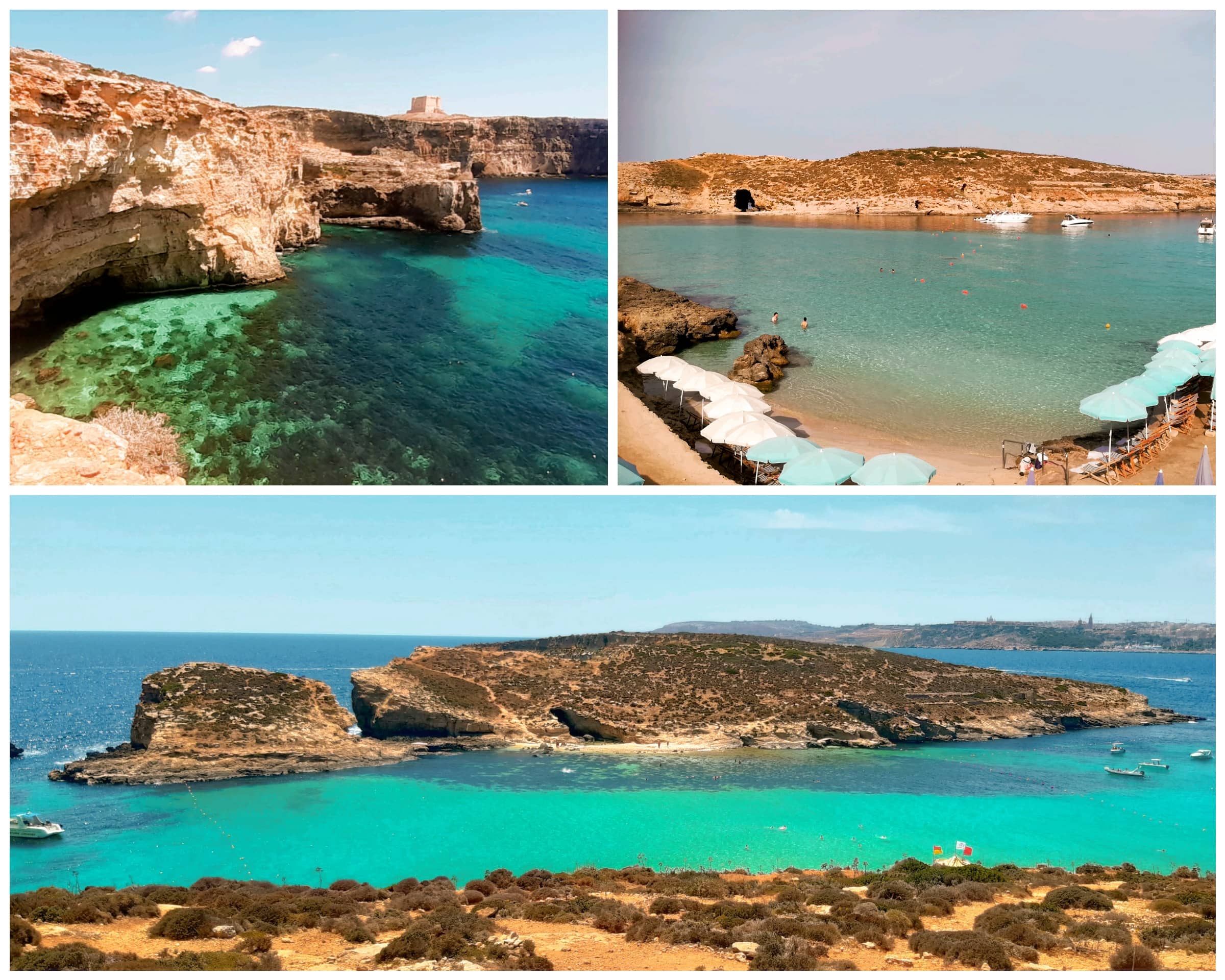
Day 7 – Golden Bay: discover the Maltese beaches
For this last day, I suggest that you discover Golden Bay, one of the rare sandy beaches of Malta. I prefer the neighbouring, wilder beach: Riviera Bay (Ghajn Tuffieha). You can swim there, or go for a hike on the heights and enjoy breathtaking panoramas.
At the end of the day, go to the tower accessible from the Riviera Bay car park to admire the sunset.
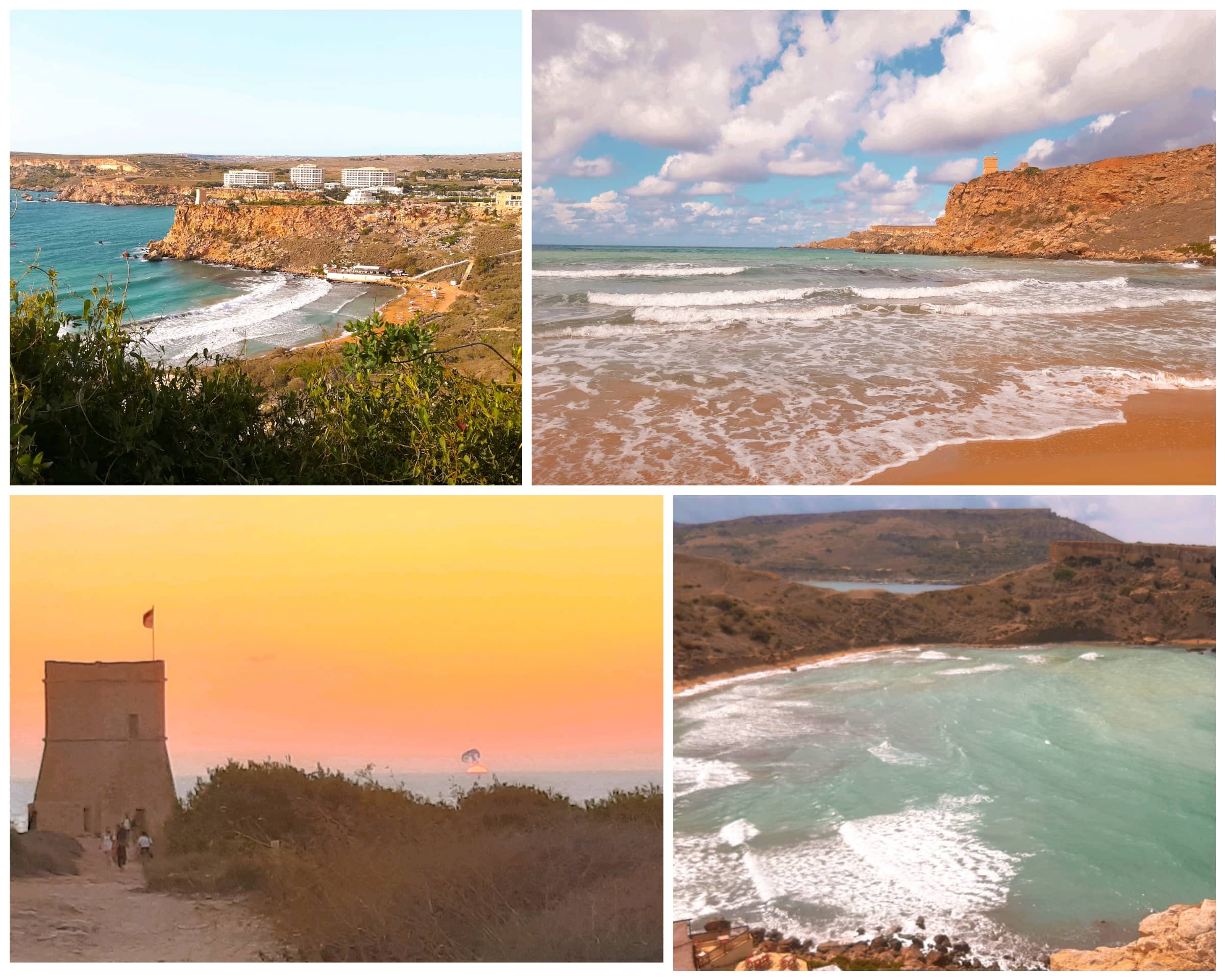
Bottom left: Sunset from the tower overlooking Ghajn Tuffieha.
Right: Ghajn Tuffieha.
I hope this blog post gave you some ideas for planning your stay in Malta.
Have a good trip and merħba (welcome in Maltese)!
Do you want to go further?
Discover my e-book to help you organise your trip to Malta!
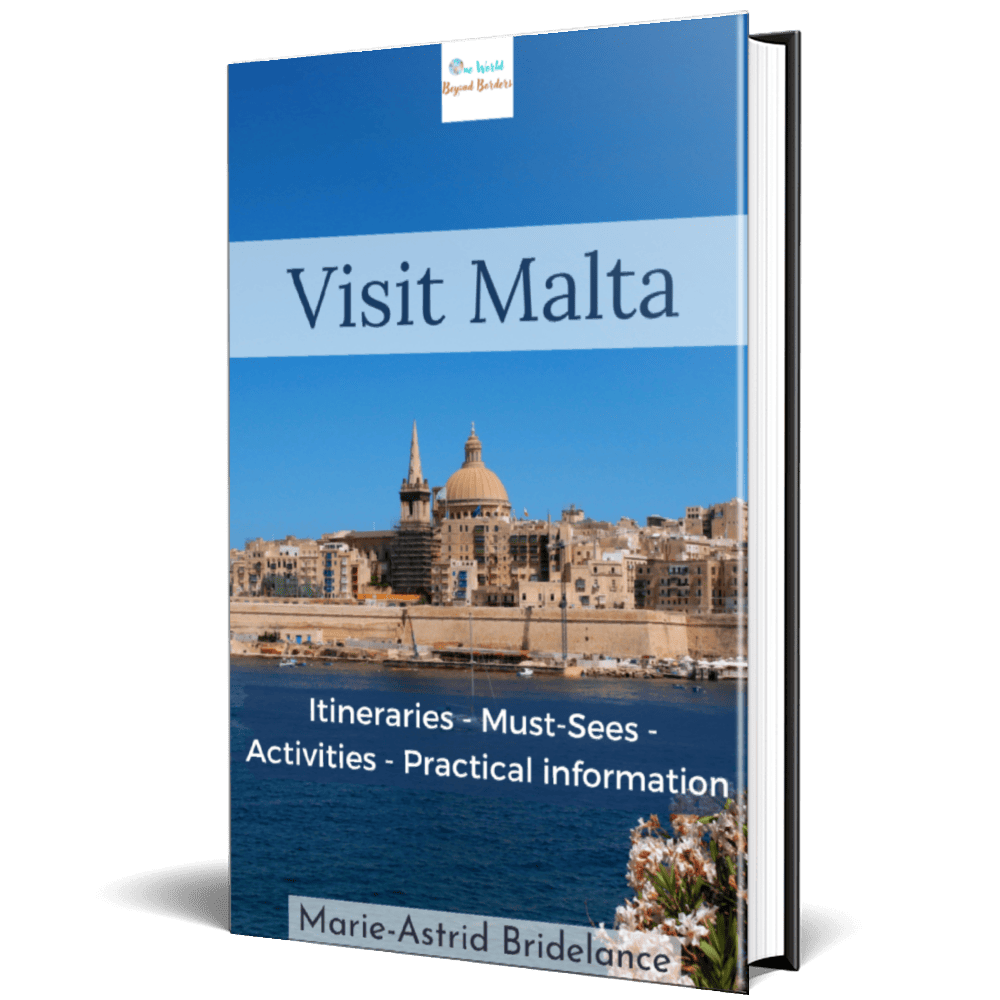
Did you like this blog post? Pin it!
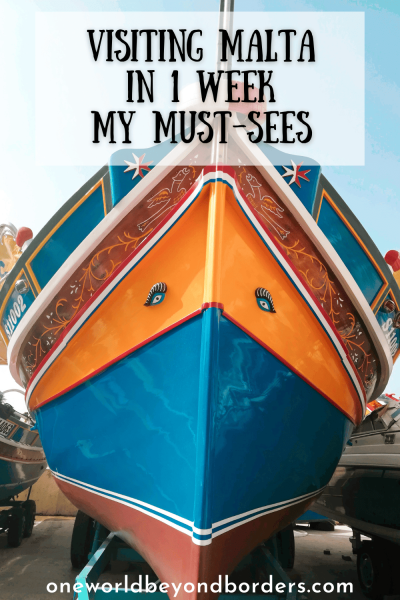


You May Also Like

My Top 10 Vegan Dishes from Around the World
24 January 2022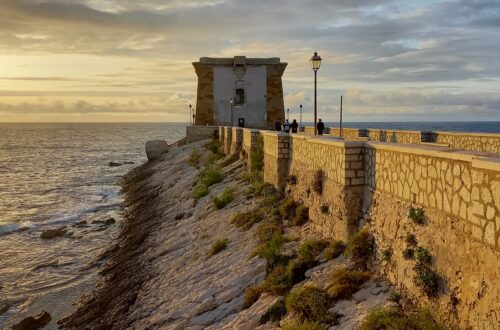
Visit Trapani in Sicily: my Top 5 Things to See and Do
3 April 2023